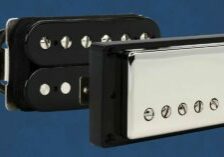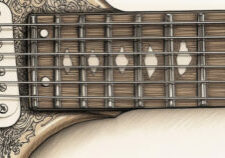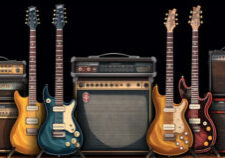Choosing the right electric guitar for your playing style can be a daunting task, especially if you are a beginner. With so many options available in the market, it can be overwhelming to decide which one to buy. However, by considering a few key factors such as your playing style, budget, and personal preferences, you can narrow down your choices and find the perfect electric guitar that suits your needs. Here are some considerations.
Understanding the Different Types of Electric Guitars
These are the most common types of electric guitars.
Solid Body Electric Guitars
Solid body electric guitars are the most common type of electric guitar. They are made entirely of solid wood and have no sound holes, which means they rely on pickups to amplify the sound. Solid body electric guitars are versatile and can be used in a variety of genres, including rock, blues, and metal.
Semi-Hollow Body Electric Guitars
Semi-hollow body electric guitars have a hollow body with a solid center block. This design allows for a more resonant sound than solid body electric guitars but still provides some resistance to feedback. Semi-hollow body electric guitars are often used in jazz and blues music.
Hollow Body Electric Guitars
Hollow body electric guitars have a completely hollow body with no center block. This design produces a warm, rich tone but is more prone to feedback than other types of electric guitars. Hollow body electric guitars are often used in jazz and blues music.
Evaluating the Neck Shape and Width
One of the most important is the neck shape and width. The neck of a guitar is where your hand will spend most of its time, so you need to choose one that feels comfortable and allows you to play your best.
The most common neck shapes are C-shaped, U-shaped, and V-shaped. C-shaped necks are the most popular, as they offer a comfortable grip for most players. U-shaped necks are thicker and offer more support for players with larger hands. V-shaped necks are less common but can be a good choice for players who prefer a more vintage feel. I used to think I liked thin shaped necks and then I went to a guitar store, played a few I liked and realized they were U-shaped. Go figure. The lesson… go to guitar store and play a lot of different guitar necks.
In addition to the shape of the neck, you’ll also want to consider its width. The width of the neck can affect how easy it is to play certain chords and how comfortable it is to hold. Narrower necks are generally easier to play for those with smaller hands, while wider necks can be more comfortable for players with larger hands.
Considering the Body Shape and Weight
The body shape of an electric guitar can have a significant impact on its sound and playability. There are a number of different shapes to choose from, each with its own unique characteristics.
One popular option is the Stratocaster-style body, which features a double-cutaway design and three single-coil pickups. This type of guitar is known for its bright, clear tone and comfortable playability. Leo Fender got it right when he made the strat. The contour body, shape and lightweight just make a dream to play.
Another common choice is the Les Paul-style body, which has a thicker, heavier design and typically features two humbucker pickups. This type of guitar is known for its warm, rich tone and sustain.
Other popular body shapes include the Telecaster-style body, which has a single-cutaway design and two single-coil pickups, and the SG-style body, which has a thinner, lighter design and typically features two humbucker pickups.
In addition to considering the body shape of an electric guitar, it’s also important to think about its weight. A heavier guitar can provide more sustain and a fuller tone, but it can also be more difficult to play for extended periods of time. On the other hand, a lighter guitar may be more comfortable to play but may not have as much sustain or depth in its tone.
Examining the Pickups and Electronics
When it comes to choosing the right electric guitar for your playing style, one of the most important factors to consider is the pickups and electronics. These components play a crucial role in determining the tone and sound of your guitar, so it’s essential to understand how they work and what options are available.
Pickups are essentially small magnets that are placed under the strings of an electric guitar. When you pluck a string, it vibrates and creates a magnetic field that is picked up by the pickups. This signal is then sent through the guitar’s electronics and out to an amplifier or other sound system.
There are two main types of pickups: single-coil and humbucker. Single-coil pickups are known for their bright, clear tone and are often used in genres like country, blues, and surf rock. Humbuckers, on the other hand, have a thicker, more powerful sound that is well-suited for heavier styles like metal and hard rock.
If you’re not sure which type of pickup is right for you, it’s worth trying out guitars with both options to see which one you prefer. Keep in mind that some guitars come with multiple pickups, allowing you to switch between different sounds depending on your needs.
Another factor to consider when examining the electronics of an electric guitar is the control layout. Most guitars have at least one volume knob and one tone knob, but some models may have additional controls like a pickup selector switch or a coil tap.
A pickup selector switch allows you to choose which pickup(s) are active at any given time. This can be useful if you want to switch between different sounds quickly without having to adjust your amp settings. A coil tap, on the other hand, allows you to split a humbucker pickup into two single-coil pickups. This can give you even more tonal options and allow you to create unique sounds that aren’t possible with standard pickups.
It’s also worth considering the quality of the electronics when choosing an electric guitar. Cheaper guitars may have lower-quality components that can affect the sound and reliability of the instrument. Look for guitars with high-quality pickups and electronics from reputable brands to ensure that you’re getting a guitar that will sound great and last for years to come.
Testing the Sound and Tone Quality
When it comes to choosing the right electric guitar for your playing style, one of the most important factors to consider is the sound and tone quality. After all, the sound of your guitar is what will ultimately determine how your music sounds to others. Here are some tips on how to test the sound and tone quality of an electric guitar before making a purchase.
Firstly, it’s important to understand that there are many different factors that can affect the sound and tone quality of an electric guitar. These include the type of wood used in the body and neck, the pickups, the bridge, and even the strings. As such, it’s important to take a holistic approach when testing a guitar’s sound and tone quality.
One of the first things you should do when testing a guitar is to play it acoustically. This means playing it without plugging it into an amplifier. By doing this, you can get a sense of how the guitar sounds on its own, without any external effects or amplification. Pay attention to things like sustain, resonance, and overall tonal balance.
Once you’ve played the guitar acoustically, it’s time to plug it in and test it through an amplifier. When doing this, make sure to use an amp that is similar to what you would normally use when playing live or recording. This will give you a more accurate sense of how the guitar will sound in real-world situations.
When testing the guitar through an amp, start by playing some simple chords or riffs. Listen for things like clarity, definition, and note separation. You want each note to ring out clearly and distinctly, without any muddiness or distortion.
Next, try playing some lead lines or solos. Pay attention to how well the guitar sustains notes and how easy it is to bend strings. You want a guitar that allows you to express yourself musically without feeling limited by its technical capabilities.
Another important factor to consider when testing a guitar’s sound and tone quality is its versatility. Can it handle a wide range of playing styles and genres? Does it sound good when playing clean, as well as when using distortion or other effects? A versatile guitar will allow you to explore different musical styles and express yourself in new and creative ways.
I play a wide variety of music from Hendrix to AC/DC and Metallica. If I only had 1 guitar I would have an HSS . This means its Humbucker, Single Coil, Single Coil. The humbucker has a higher output and can give you that metal tone. The middle pickup can get you the bright chimey sound while the necks can get you that creamy lead sound.
Finally, don’t forget to trust your ears. Ultimately, the sound and tone quality of a guitar is a subjective thing. What sounds great to one person may not sound as good to another. As such, it’s important to trust your own instincts and choose a guitar that sounds good to you.
Checking the Hardware and Bridge System
You’ll want to consider the type of bridge system that’s best suited to your playing style. There are several different types to choose from, each with its own unique characteristics.
One popular option is the fixed bridge, which is also known as a hardtail bridge. This type of bridge is simple and straightforward, with no moving parts or tremolo system. It’s a great choice for players who prefer a stable, predictable sound and don’t need the added versatility of a tremolo.
Another option is the tremolo bridge, which allows you to bend notes and create vibrato effects by moving the bridge up and down. This can be a great tool for adding expression and emotion to your playing, but it can also make tuning more difficult and require more maintenance.
You might consider a locking tremolo system like the Floyd Rose and variations. This type of bridge uses locking nuts and fine tuners to keep your strings in tune even when using extreme whammy bar techniques. However, it can be more complex to set up and maintain than other types of bridges.
Once you’ve chosen a bridge system that suits your needs, it’s time to consider the other hardware components on your guitar such as the tuning machines, which are responsible for keeping your guitar in tune. There are several different types of tuning machines available, but most fall into two categories: locking and non-locking.
Locking tuners use a mechanism that clamps down on the string, preventing it from slipping out of tune. This can be especially useful if you’re using a tremolo system or playing in alternate tunings. Non-locking tuners, on the other hand, are simpler and more traditional, but may require more frequent tuning adjustments.
Setting a Realistic Budget for Your Electric Guitar Purchase
When it comes to buying an electric guitar, there are a lot of factors to consider. One of the most important is setting a realistic budget for your purchase. With so many options available, it can be easy to get carried away and overspend on a guitar that may not even be the best fit for your playing style.
The first step in setting a budget is to determine how much you can realistically afford to spend. This will depend on your personal financial situation, as well as how serious you are about playing the guitar. If you’re just starting out and aren’t sure if you’ll stick with it, you may want to start with a lower-priced guitar until you’re more committed.
Once you have a general idea of your budget, it’s important to do some research on the different types of electric guitars available. There are many different brands and models to choose from, each with their own unique features and price points. Some popular brands include Fender, Gibson, and Ibanez, but there are many others as well.
When considering different guitars, think about your playing style and what type of music you want to play. For example, if you’re interested in playing heavy metal or hard rock, you may want to look for a guitar with humbucker pickups and a solid body for maximum sustain and distortion. On the other hand, if you’re more interested in playing blues or jazz, you may want to look for a guitar with single-coil pickups and a semi-hollow or hollow body for a warmer tone.
Another factor to consider when setting your budget is whether you want to buy new or used. While buying new can be more expensive, it also comes with the peace of mind of knowing that the guitar hasn’t been played before and is in top condition. However, buying used can be a great way to save money while still getting a high-quality instrument. Just be sure to inspect the guitar carefully before making a purchase to ensure that it’s in good condition.
I’m a big proponent of buying used. Often you can buy something and sell it for a similar price in the future. Yeah, you might buy something you don’t like, but generally you can just sell it and by something else without taking a big loss.





